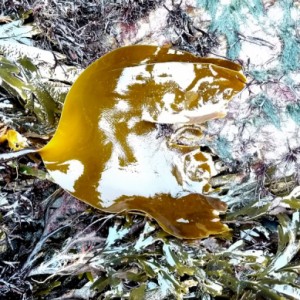Sea roads
It's that time of the year and the month when the moon's gravitational pull sucks the tide right out and you can see the kelp fronds dancing and bobbing in the surf. Rough weather has torn quantities of it from the sea bed and cast it in heaps on the beach. I used to regard it simply as marine debris but lately I've come to see kelp in a new light.
It grows in offshore sea forests around the temperate coasts of the northern and southern hemispheres and, like terrestrial forests, it provides a home and a food source for other species, from micro-organisms that live on its surface and within in its anchoring holdfasts, to molluscs and bivalves, fish and crustaceans, birds and sea mammals that find prey or protection within its submarine fronds. Human beings were attracted to the kelp beds at an early stage in their evolution and some of our earliest ancestral traces have been found close by this great natural larder.
In recent years the notion of a "kelp highway" has emerged to account for one of the greatest archaeological debates of all time: whence came the people who formed America's first great wave of immigration? The old hypothesis had them crossing the ancient land bridge across the Bering Strait and filtering down into mainland North America as the glacial ice sheets melted and trees began to cover the surface of the land.
But ancient sites excavated in southern parts of the USA and in South America have revealed material that has been dated to way before the North American glaciation ended and this has posed the question 'How did the people get there?' if the land to the north was ice-bound and the oceans too vast for primitive navigation.
One intriguing hypothesis is that they arrived via the Kelp Highway crossing from Asia to hug the seaweedy shores of Alaska and thence moving south. Clearly these pioneering people would be travelling in a very slowest lane, taking many thousands of years and hundreds of generations to explore, settle and move on but all along the way the kelp would provision them. Not only could they catch the animals living in, and attracted to, the seaweed but kelp itself has been identified as part of their own diet, and in addition could be used as fuel and building material. Only small simple boats would have been needed in the shallow waters and no doubt these shore-dwellers would have been more or less amphibious in their own lifestyle. As time went on and the hinterland was colonised there were still significant links with the shore, establishing routes for foraging and trading.
The kelp highway hypothesis is not definitive, it's only one of several theories about the spread of Homo sapiens across the continents of North and South America, and the whole debate is highly disputatious. Brief summaries can be found here, here, and here, and this one about the Monte Verde excavations in Chile, dated at 20,000 years older than the oldest North American site, has interesting things to say about seaweed in the diet.
Kelp doesn't grow in the tropics and, all too predictably, global warming and rising sea temperatures are slowly but surely destroying the growth of kelp in those areas of the world that used to support it - see here.
Extra: kelp and other seaweeds


Comments
Sign in or get an account to comment.


